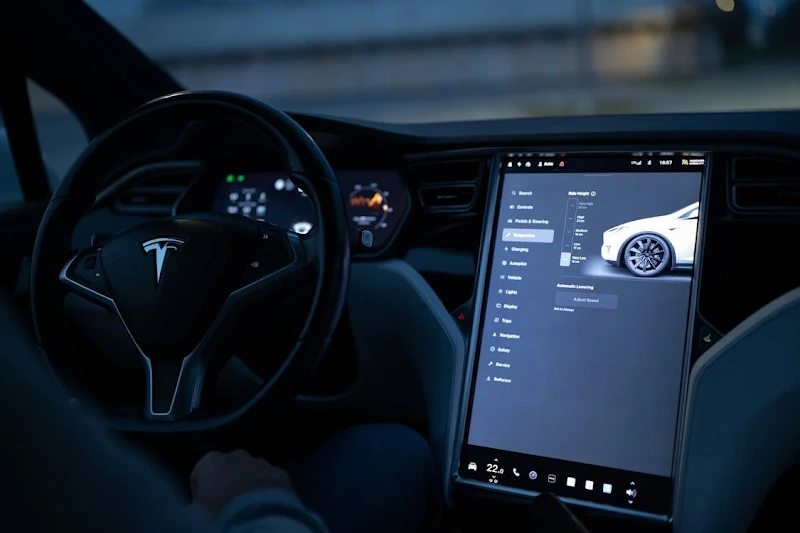The Influence of AI on the Automotive Sector: The Future Awaits

Stellar software systems that could analyze large swathes of data and execute tasks like humans do are now a necessity; the automotive industry AI system is slowly onboard. The incorporation of AI into vehicles changes the way they are constructed, used, and even perceived. Self-driven cars that can glide in the middle of traffic and automated dashboards that switch songs depending on the user's mood are all we can imagine, right? In this article, we will explore the influence of AI on the whole automotive sector in detail.
Self-Driving Cars: The Future of AI in Driving
Self-driving and autonomous vehicles are barely part of the present scenario but strive to dominate the near future. This application of AI is what gets people talking and its machinery is not comparable to cars that we know of: special sensors, robots, and AI make this vehicle stand out. Advanced algorithms make this automobile different from all the rest. With enormous headway in technology over the past few years, I am confident we will be seeing these cars hit the streets in no time. We aren’t jumping into robotaxis just yet, but the pace of change is impressive, with car manufacturers and tech companies working to stretch the limits.
How it works: Picture a car that can see, hear, and act like a human driver. AVs rely on artificial intelligence to interpret data from cameras, lidar radar, regular radar, and other sensors. All of these sensors combine to create a 360-degree view of the environment – other cars, people walking, traffic signals, and even road markings. At this stage, AI algorithms take over to process all the data and estimate what other drivers intend to do and what the optimal course of action will be.
Potential benefits: Try imagining a world where car accidents are much less frequent (so long human recklessness), where the elderly and disabled can move around freely, and where fewer traffic jams are experienced because cars can drive on a more intelligent level.
Challenges: A self-driving car that is truly safe and dependable is a massive challenge to create. AI systems should assume that they will find themselves in difficult conditions, like unexpected weather, sudden barriers, or other drivers who do not obey any rules.
2. Improved Safety Features: AI at Your Service
Many of us still envision a world where self-driving cars are the reality, but before that happens, AI has revolutionized safety in modern cars. Advanced driver-assistance systems (ADAS) utilize AI to escalate safety provisions and give real-time assistance to drivers.
Some Examples of ADAS systems Enhanced with AI:
Automatic Emergency Braking: This safety feature is capable of independently braking the vehicle when you are so preoccupied with other things in traffic that the events pass you by at a slow pace.
Lane Departure Warning and Lane Keeping Assist: Normally, these systems will bring it to your attention when the car traveling out of your lane and steer you slightly back into your lane if it shifts onto the shoulder. Additionally, lane-keeping assists might kick in and stay out of your trip to other lanes.
Adaptive Cruise Control: In this regard, AI in the form of the cruise control system, could also perfectly gear this by tracking the presence of other cars. It will slow down or speed up depending on the vehicle ahead so that a safe distance is maintained.
Blind Spot Monitoring: It alerts you when other vehicles are approaching your blind spots with AI guidance.
Advantages: These provisions enabled through AI technology address negligence and safety driving issues, subsequently enhancing road safety for drivers and pedestrians alike.
3. Car Assistant: Custom Passenger Meaningful Interactions with Technology In Vehicle
AI ensures that vehicles are easier and more convenient. Consider a car that understands your specific preferences and modifies the temperature, music, navigation, and so on.
Here are some examples below
Voice assistants: Your vehicle’s AI voice assistant can perform various tasks while driving, like taking control of navigation, music, and climate settings without requiring your hands off the wheel, similar to Siri or Alexa.
Personalized infotainment: Based on your preferences related to musical genres, AI can create types of news you prefer to listen to, custom playlist, and recommend articles you enjoy reading
Predictive maintenance: AI is capable of determining when your car might need maintenance from the data being collected by your vehicle’s sensors, which is very useful in avoiding potential breakdowns.
Benefits: These AI features make driving activities exhilarating, soothing, and less worrying altogether.
4. Manufacturing and Design: AI on the Factory Floor
AI is not only changing the way we drive but also how we create cars. The use of AI-powered robots is capable of speeding up the production process and increasing efficiency through heavier automation of the majority of manufacturing processes. AI also assists in better car designs that optimize aerodynamics and increase fuel efficiency.
Examples
Robotic assembly: Tasks on the assembly line that require welding and painting can be automated with AI-powered robots.
Predictive maintenance in manufacturing: Artificial Intelligence can forecast the time in which manufacturing equipment should undergo maintenance in your car, decreasing intervals where productivity is halted.
Generative design: Engineers will have more creative and original options to work with the help of AI regarding different design alternatives they can get.
Benefits: AI is improving the Automotive industry by increasing the efficiency of car manufacturing, reducing costs, and fostering innovation in the field.
5. The Challenges and Considerations:
No matter how advantageous AI seems to be for the car industry, there are still some challenges that must be resolved.
Ethical concerns: Autonomous vehicles are very complex not just technologically, but also ethically, as they pose serious questions regarding the decisions taken in the matter of unavoidable accidents.
Data privacy and security: The AI systems demand a lot of data which boils down to the question of privacy and security.
Job displacement: The growth of automation in manufacturing processes along with the proliferation of miniaturized computers in vehicles can result in mass unemployment for certain groups.
Regulatory framework: For AI-equipped car technology to work safely and responsibly, there need to be precise guidelines on how it is applied.
Q1: Will self-driving cars completely replace human drivers?
That is the tricky part. The reality is that self-driving technology is maturing at an astonishing speed, so the shift is likely to be incremental. It’s safe to predict that for a long time to come, there will be a combination of self-driving cars and vehicles driven by people.
Q2. Are AI-powered safety features available in all new cars?
Not all updated versions of a vehicle. Some AI-controlled safety features like automatic emergency braking are available in most cars, but others are only available for expensive purchases.
Q3: Where can I find more information about AI in automotive?
The internet is full of such resources! Articles and reports from car brands and tech companies along with industry magazines provide a lot of useful information. There is also a vast collection of videos and documentaries that discuss the topic at length.
The Road Ahead:
AI promises to revolutionize the entire automobile industry, including how cars are driven and built. There are lots of problems that need to be solved, but the potential benefits AI brings to this field are paramount. With continuous improvement in AI, we can expect more advanced innovations in the coming years, enabling a future that is safe, efficient, and custom-tailored.
Like this project
Posted Mar 26, 2025
The Influence of AI on the Automotive Sector: The Future Awaits Stellar software systems that could analyze large swathes of data and execute tasks like hum…
Likes
0
Views
1
Timeline
Feb 8, 2024 - Apr 14, 2024







